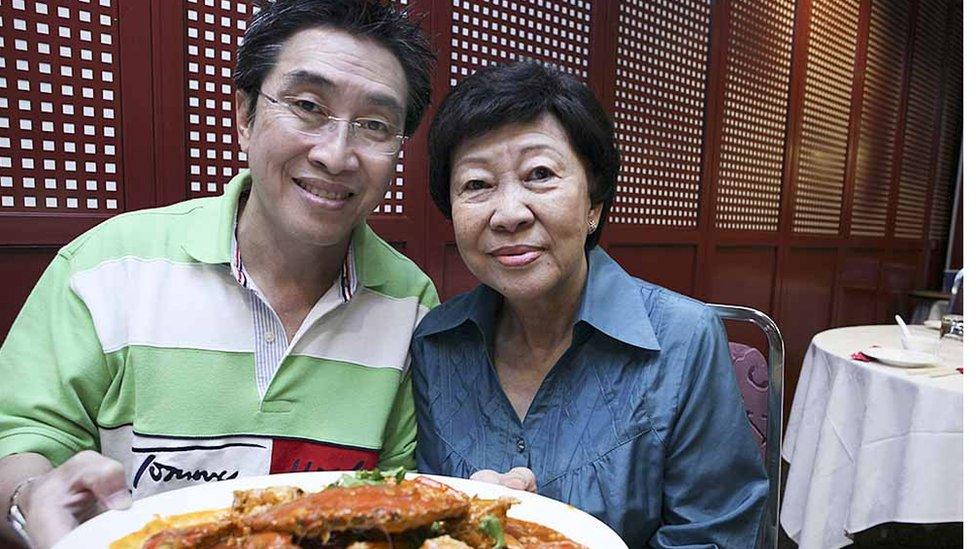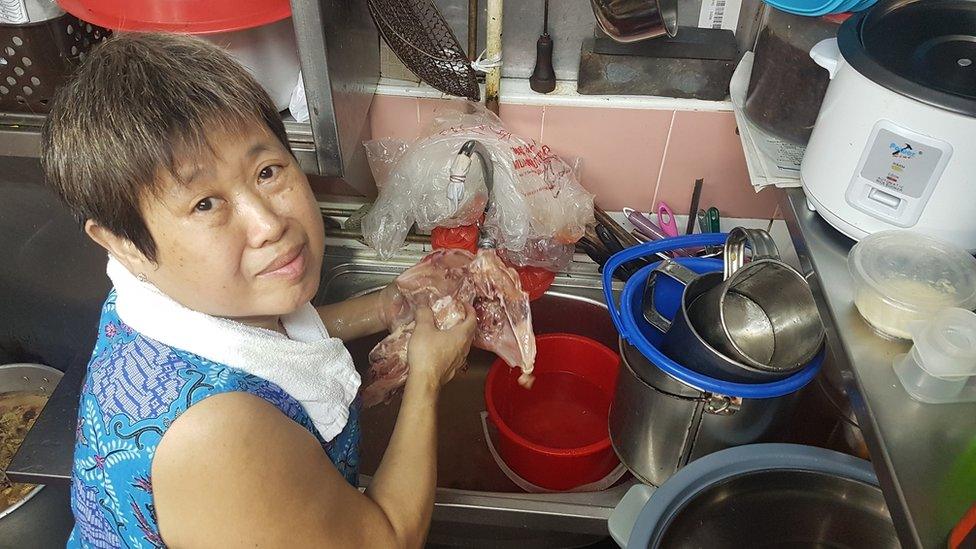Chilli crab: The woman behind Singapore's beloved dish
- Published

Chilli crab, or mud crabs cooked in savoury tomato and chilli sauces as well as eggs, is an iconic dish in Singapore
It began, as many great inventions do, with an accidental discovery.
More than 70 years ago, Cher Yam Tian had a request from her husband Lim Choon Ngee, a policeman who was fond of fishing and catching mud crabs by the beach: instead of steaming the crabs, could she try something different?
So she stir-fried the crabs in tomato sauce. Her husband thought it tasted good but perhaps too sweet - he suggested she add a little chilli to the sauce. That's how the story goes, according to Dr Leslie Tay, who runs the popular Singaporean food blog ieatishootipost, external.
Ms Cher died on Wednesday in Singapore at the age of 90. Local media reported that she had a lung infection which developed into pneumonia. Soon the tributes began pouring in, remembering the creator of what has now become a world-renowned dish, beloved in Singapore and consistently ranked among some of the most delicious meals anywhere.
When Ms Cher made the dish for family and friends, it turned out to be such a hit that she started selling it on a push cart. The year was 1950. She called it chilli crab.
Six years later, she progressed to a little shack lit by hurricane lamps, before the Lims opened an eatery called Palm Beach Seafood in 1963. It was named for the palm trees that lined the nearby beach.
The recipe was later modified by the famous Singaporean chef Hooi Kok Wai, who added eggs and sambal, a concoction made of chilli peppers and prawn paste.
And that is the modern-day chilli crab that Singapore loves - stir-fried crab swimming in a thick, sweet and savoury sauce, typically served with fried or steamed buns called mantou.
"The eggs thicken the sauce and add a bit of flavour," Dr Tay says.
As familiar as the dish is to Singaporeans today, there was nothing quite like it back when Ms Cher first experimented with it, culinary experts say.
"For someone to come up with a dish that audacious, you pique people's curiosity. People eat it, it is a dish that sticks. These are flavours you remember," said Singaporean food critic KF Seetoh, who considers Ms Cher a "culinary hero" of the country.
"She created a dish that rose above. It is the most iconic seafood dish here."
Mr Tay also reckons that chilli crab, alongside the ubiquitous chicken rice, are the two dishes that Singapore is best-known for internationally. That takes some doing in a country with a dizzying array of food from different cultures. Not to mention the hefty cost - depending on weight and variety, a dish of chilli crab in Singapore usually starts at around S$80 (£50; US$60).
"Putting Singapore and chilli crab on the world map, that's quite an achievement," he mused. "Nobody plans these sort of things. Nobody says, I'm going to create a dish and take over the world."
Dr Tay first met Ms Cher back in 2009 in a bid to understand the history of the dish. This was in the wake of Malaysia's former tourism minister Ng Yen Yen's claim that chilli crab was one of several Malaysian dishes that had been wrongly credited to other countries. The remark still stirs indignation among Singaporeans.
"She was a little bit upset that people would make such claims," recalled Dr Tay of the "spritely lady" who was then in her 70s. "She said, 'I was the one who came up with it'. She saw it as the thing that she contributed to Singapore culture."

Cher Yam Tian and her son Roland Lim, pictured in 2009
The long-standing rivalry between Singapore and Malaysia, which were once part of the same country, is often evident in their food. Forget bilateral disputes over territorial claims or economic issues - there are few things that can rile up citizens of both sides like food, especially when it comes to claiming dishes that both countries have in common.
A case in point is Dr Tay's dismissal of Ms Ng's claims as "ludicrous assertions". He is adamant that while other places may claim to serve chilli crab, Singapore's iteration of the dish is unique.
"Ms Cher was the one who started it. When you come to Singapore and you ask for chilli crab, you only get one version of it."
As far as he is concerned, chilli crab is a "great Singapore dish" and a cultural icon.
Ms Cher was an innovator, Dr Tay says, pointing out that she created other well-known Singaporean dishes such as tao you prawns (prawns fried in caramelised dark soya sauce) and sotong you tiao (squid fritters).
Alongside the original version of chilli crab, these dishes are still being served at the 1,000-seater Roland Restaurant, which is run by her sons Roland Lim, 65, and Richard Lim, 60. Palm Beach was sold in 1985, while Roland Restaurant was set up in 2000 after Roland took over his godfather's restaurant and renamed it.
"Even up till today, the chilli crab sauce is a family secret. I couldn't pry anything out of them," said Dr Tay with a laugh.
Would people still be eating chilli crab 30 years from now? Mr Seetoh says yes, because it has been seven decades since its invention and the dish still remains popular.
"Once you cross 50 years, people will be eating it forever, unless you run out of crabs."
- Published19 March 2020

- Published30 July 2022
